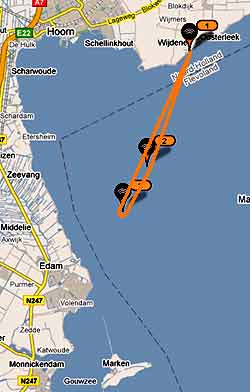Today I paddled the Cetus on the IJsselmeer in a 6-7Bft SW-wind.(gusts up to 8Bft)
A perfect area for testing in the conditions of today was the "Hoornse Hop". We choose to start at Wijdenes and paddle against the wind in the direction of Edam. Doing so we could plan our trip better. As you never know how fast you can go in these winds, you can always turn back once time is over. With this crossing we challenged the heaviest part of the area.

As said, our first leg was against the wind and the second the same way backwards promising some nice surfing.
Normally I count with an average speed of 3 km/h against strong winds, but today we paddled near 5km/h , which is not bad at all. The Cetus, but also Wieger's Exite accompanying me, was not hold back in speed by the steep, short waves when we worked ourselves against the wind. On the contrary: she just glided over the waves only occasionally getting water on the front deck. The only spray I got into my face was caused by the kayak slamming down on the water after particular steep waves.
While paddling against the wind the Cetus behaved a bit nervous because she tried to follow the mixed, disturbed waves and wandered of course quickly. At first I tried to calm her by dropping the skeg a bit, but that was a mistake because this caused leecocking when a wind-gust blew the bow aside. Bad idea, so I hauled the skeg up again. After a while I got used to this behaviour of the Cetus. Actually I was quite happy with her manoeuvrability as this made it easy to bring the Cetus back on track once a wind-gust blew the Cetus of her course. So probably it is not fair to call the Cetus nervous; therefor I think it is best to change that in manoeuvrable.
The stability of the Cetus was outstanding. This is best illustrated by the fact that I could easily take pictures and eat something without support: In this wind with one hand on my paddle.
After 12 km we turned back and we tried to surf as much waves we could. Surfing the Cetus is not very easy because she quickly broaches to a side, even with the skeg dropped completely, when the waves are a bit irregular: She just follows the disturbances in the wave-surface. However: in a very big smooth wave she surfs very well. Fast she goes ;-))
Wieger's Exite just surfs better and he had to wait several times for me, to prevent disappearing after the horizon.
After some time I became tired/hopeless of getting swept 90° of course frequently and turning back on course again and therefor I stopped trying to surf. Instead I just tried to keep the Cetus going on our desired course. This worked quite well as the Cetus did not come to surf on her own. You can mention this as a good and safe characteristic because when you don't get into surf it is easier to control the kayak.
I thought this strategy of not trying to surf being the most convenient way to paddle the Cetus in following waves. Of course I did not reach the speed the Wieger's Exite reached while surfing.
When we approached the headland near to Wijdenes, the wind increased to 7Bft with gusts up to 8Bft. This spot is normally the most turbulant of the area, but now the water grew wild and the waves were somewhere between 1,5-2 meters high. Fascinating!
But: in the middle of this circus my footrest on the right side suddenly move forward out of reach of my foot. The adjustment system of the footrest, as I saw afterwards, just released the blocking mechanism. Probably the continuous slamming down waves during the trip made it turn a bit. OR, I just did not block it correctly.
However: without footcontact it is difficult to make fun in these conditions.
If you have a P&H-kayak with this new easy-adjust-footbrace-system, I would like to warn you to adjust and lock the footbraces properly to prevent for the experience I had.
With only 1 footbrace left, I had to switch to a survival-strategy in the big waves, meaning that I prevented coming into a surf, preventing on broaching and keeping the kayak on course while bracing if a wave started cresting and letting the wind blow me further. I was very happy with the stability of the Cetus at this moment because this surely helped in controlling the kayak while having insufficient contact in the cockpit. I am not sure if I could perform a roll with only 1 footbrace.
That this last part had been a tiring way of paddling became clear to me when I entered the little harbour of Wijdenes. I had to turn left into the wind to enter it and I hauled up the skeg to make this turn easier, using of the weathercock-tendency of the kayak. Only a few sweepstrokes were necessary to make the turn, but doing so the delta muscles of my back cramped and I had to stretch them between strokes. This cramping was new to me; never experienced this before.
Nevertheless this was a very interesting trip with the Cetus and I can appreciate her under these circumstances: I felt quite safe during the trip.
